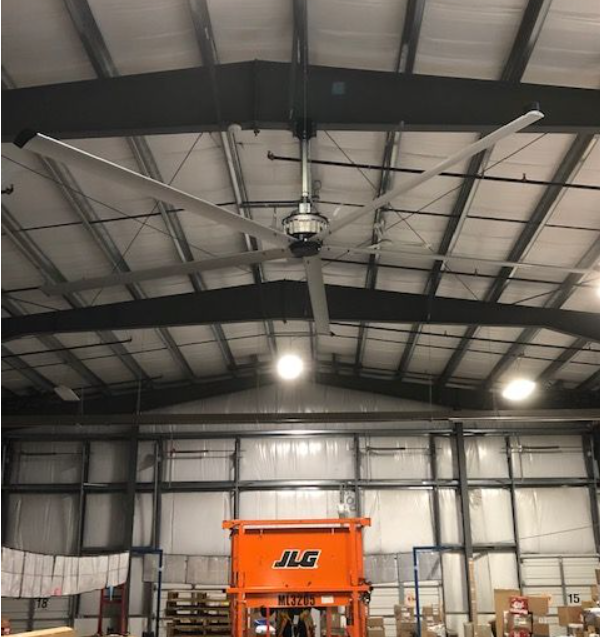
In the bustling world of factories and warehouses, where efficiency is crucial, the steady hum of machines and fans is simply part of the environment. Amidst all the activity, there’s an increasing demand for operations to run smoothly without adding to the noise. Enter industrial ceiling fans – these towering fixtures that hang above us like silent guardians have quietly evolved in recent years thanks to noise reduction technology.
Let’s take a closer look at how these big, quiet fans are changing the game in industrial ventilation, all while keeping up with important airflow measurements like CFM for fans.
Noise Reduction — Why is it Necessary?
Excessive noise issues go beyond just feeling frazzled. Constant loud environments put your hearing at risk long-term. What seems like a temporary ring in your ears could worsen into permanent damage down the road. That’s why finding ways to make machines quieter, including industrial fans, is so important.
Regular industrial ceiling fans do a good job of keeping air moving, but they also tend to add a lot of noise to the background. As those big blades spin through the air, they create turbulence that we can hear as noise. This noise can range from mildly bothersome to really disruptive, depending on things like how big the fan is, how fast it’s going, and what it looks like.
The Introduction of Noise Reduction Technology
In response to the growing demand for calmer work settings, companies have embraced creative solutions to tackle the loudness stemming from ceiling fans in industrial spaces. One exciting advancement involves adopting aerodynamic blade designs. By finely tuning the shape and curve of these blades, manufacturers can greatly decrease turbulence and disruptions in airflow, resulting in less noise. Moreover, progress in materials science has brought about composite blades. These blades are not only sturdy and lightweight but also naturally quieter compared to traditional metal ones.
In the pursuit of quieter industrial fans, the motor plays a crucial role. Older fan models typically had motors that generated a lot of noise because of vibrations and mechanical friction. But nowadays, modern industrial ceiling fans come with carefully designed motors. These motors are fitted with special features like vibration-dampening mechanisms and advanced bearing systems. These improvements team up to make the motor much quieter, so the fan hums along smoothly and peacefully, even when it’s revving up to full speed.
The fan isn’t just a machine; it’s like a smart system crafted to fit right in with its environment effortlessly. This goes beyond its physical parts; it involves cutting-edge control mechanisms.
Have you heard of Variable Frequency Drives (VFDs)? They’re like the conductors of an orchestra, allowing precise adjustments to the fan’s speed. This means we can tailor the airflow to match specific needs. It’s not just about saving energy, though that’s a big plus. It’s also about creating a serene atmosphere, free from unnecessary racket when things are quiet.
Maintaining CFM for Fans
While striving for quieter industrial ceiling fans is commendable, we must remember their core function: to effectively circulate air and maintain ventilation in industrial settings. It’s important to ensure that any improvements in noise reduction don’t compromise performance.
A crucial factor to consider is CFM, which measures the volume of air a fan can move in a minute and directly impacts ventilation efficiency. As manufacturers incorporate noise reduction technology, maintaining or enhancing CFM values is essential. Fortunately, advancements in aerodynamics, motor efficiency, and control systems have allowed manufacturers to achieve quieter operation while preserving or even improving airflow performance.
One way to keep the air flowing strongly while making less noise is by tinkering with how the fan blades are angled and how fast they spin. This tweaking lets makers find the sweet spot between moving air effectively and keeping things quiet. Plus, using fancy computer simulations that mimic how air moves (called computational fluid dynamics) helps engineers make super precise designs for the blades. This means they can make blades that push a lot of air without causing a lot of commotion.
On top of that, motor tech has gotten better, so now we’ve got motors that are both more efficient and stronger. That means they can keep the air flowing fast without making too much noise. Combine these high-powered motors with blades designed to cut through the air smoothly, and you’ve got industrial ceiling fans that can move a ton of air without sounding like a jet engine.
Conclusion
As people increasingly seek quieter and more effective ventilation solutions for industries, the technology for reducing noise is advancing. Whether it’s improving how air flows, discovering better materials, or refining digital controls, one thing is clear: loud industrial fans are becoming a thing of the past. Instead, we’re moving towards a future where efficiency goes hand in hand with peaceful operation.
Here at Refresh Fans, we leverage our deep expertise in large-scale and efficient ventilation systems to create solutions that tackle real-world challenges. Our team believes that what sets Refresh Fans apart is the elegant simplicity of how air moves, aiding organizations across various sectors like industry, commerce, and agriculture in achieving optimal outcomes.